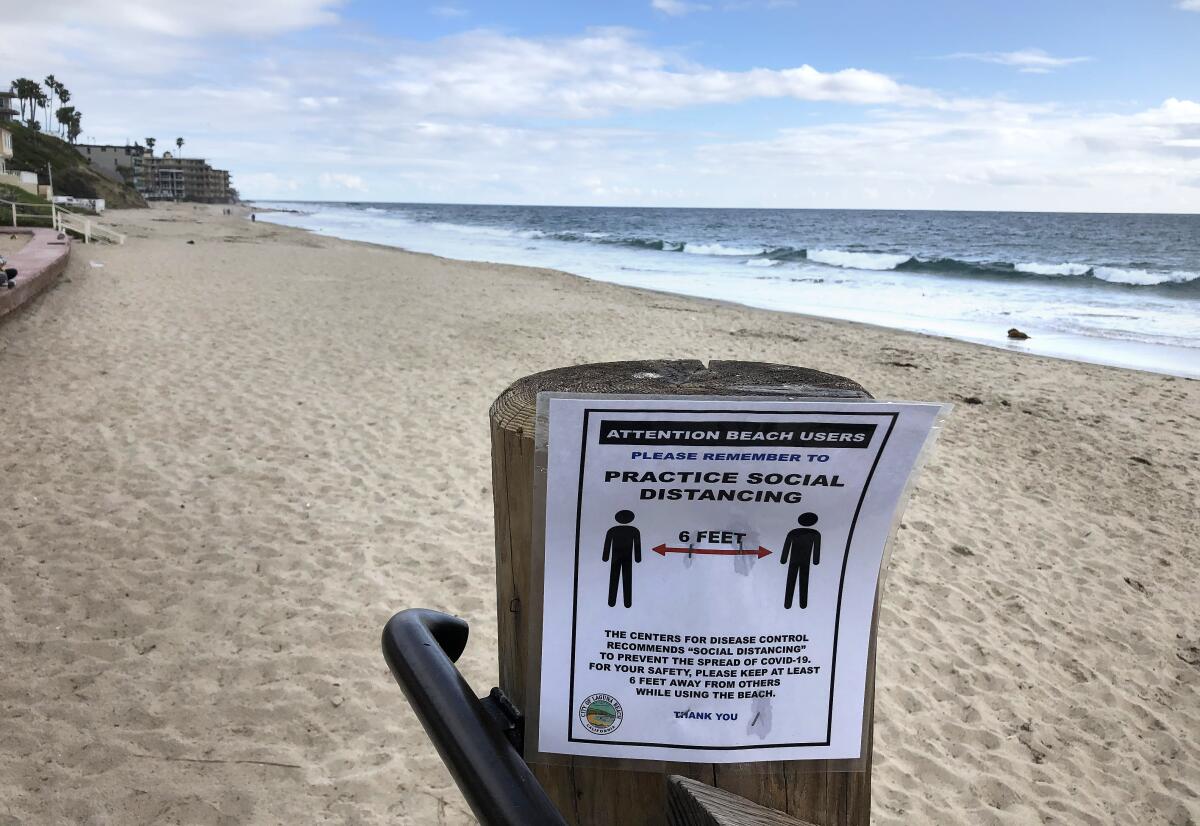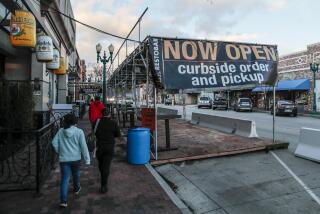California’s reopening is slowed by rising coronavirus cases, deaths

- Share via
With the economy continuing to crater, there is intense pressure to begin to open California businesses.
But even though the state has been bending the coronavirus curve, and seeing a far less dire toll than places like New York and New Jersey, a continuing spike in cases and deaths this week is one of several factors keeping officials from moving toward easing any of the social distancing rules.
Gov. Gavin Newsom said this week that most of the six milestones he set to consider loosening the stay-home order he issued last month have not been met. The only change the governor has made is to allow some elective surgeries to again be scheduled in hospitals, citing sufficient capacity.
“It will be those indicators that drive our decision-making,” he said Thursday. “Not dates. We don’t debate dates. We look at the facts objectively.”
California saw its worst one-day fatality total on Wednesday, and the rate of new cases, after seeming to flatten, is rising amid more widely available testing. More than 1,800 people have died across the state.
“It’s a reminder we’re not out of the woods yet,” Newsom said Thursday.

Danger zones
Experts say California’s early embrace of social distancing has helped slow the spread of the coronavirus.
But as the shutdown continues, they fear people will start breaking the rules, and that could be disastrous.
Newsom said he fears that if people go to beaches and parks, he’ll soon be reporting a sizable increase in the number of confirmed cases and possibly hospitalizations.
“I don’t think anybody wants to hear that. I don’t want to share that information. But that’s really less up to me, it’s more up to all of you,” he said.
California now has nearly 40,000 coroanvirus cases, with significant spikes this week. In L.A. County, officials said big increases were due in part to labs reporting batches of cases at one time. And testing has become much more available.
Still, the rising numbers are a major concern.
Deaths in Los Angeles County — which has become the state’s epicenter of the outbreak — are approaching 800, enough for the coronavirus to surpass fatalities from cancer, flu, emphysema and heart disease.
Southern California — particularly Los Angeles County — has become California’s epicenter. Total cases:
Los Angeles 17,567
Riverside 3,218
San Diego 2,643
Santa Clara 1,987
Orange 1,827
San Bernardino 1,608
Southern California also makes up the lion’s share of the hospitalizations.Nearly half of the patients are being treated in Los Angeles County, home to a quarter of the state’s population.
Los Angeles 718 (ICU) | 1,740 (other hospitalizations)
Riverside 107 | 233
San Diego 117 | 201

Positive signs
Despite the rising death toll, Los Angeles County health officials this week offered slightly rosier projections Wednesday about the trajectory of the virus while cautioning that the improved outlook was dependent on residents continuing to practice physical distancing.
Dr. Christina Ghaly, the county’s health services director, said that although COVID-19 cases are not yet decreasing here, the rate “is leveling out, which is a good thing.”
Based on the new predictions — which Ghaly cautioned are inherently uncertain — officials continue to expect to meet demand for hospital beds and ventilators. Notably, the county’s ability to meet demand for intensive care beds has improved; initial modeling said there was a 50% chance there would not be enough ICU beds, but the model now indicates the number of currently available beds will be sufficient.
Officials now predict about 2 in 20 Angelenos, or 11% of the county, could contract the virus by Aug. 1 under the current level of physical distancing. That’s a substantial reduction from the model’s original estimate that 30% of county residents could be infected.
Newsom said Thursday there had been a slight decline in two other key indicators: the number of people hospitalized and those being treated in intensive care units.
California continues to see far fewer deaths than some other hotspots:
New York 20,973
New Jersey 5,426
Michigan 2,977
Massachusetts 2,360
Pennsylvania 1,724
Illinois 1,688
Connecticut 1,639
Louisiana 1,599
California 1,531

Looking forward
The state for weeks has listed six things that would need to happen before stay-at-home could be lifted.
They include the ability to closely monitor and track potential cases, prevent infection of high-risk people, prepare hospitals to handle surges, develop therapies to meet demand, ensure schools, businesses and child-care facilities can support social distancing, and develop guidelines for when to ask Californians to stay home again if necessary.
Experts have said lifting social distancing rules will be a long and deliberate process, with some businesses coming back before others. For example, restaurants might be able to reopen with strict social distancing, but big events would be harder to restart anytime soon.
Some California communities have pressed Newsom to ease restrictions in areas where the coronavirus has not appear to spread dramatically.
But the governor has resisted.
COVID-19 remains a serious and growing health threat and loosening his statewide order prematurely could lead to a second wave of infections and fatalities, he said.
“I wish I could prescribe a specific date to say, well, we can turn up the light switch and go back to normalcy,” Newsom said Wednesday. “We have tried to make it crystal clear that there is no light switch. And there is no date in terms of our capacity to provide the kind of clarity that I know so many of you demand and deserve.”
Testing could be a gamechanger, however.
Newsom on Wednesday announced an expansion of coronavirus testing capability throughout California, saying the findings will be critical to deciding when to ease the state’s strict stay-at-home order and allow people to return to work.
Despite several protests over California’s stay-at-home order to slow the spread of coronavirus, a new poll shows the vast majority of residents support the restrictions.
Among those polled, 75% want the order to continue as long as it’s needed, according to a California Health Care Foundation/Ipsos survey. Only 11% wanted to stop the stay-at-home order, while 13% had no opinion. Among low-income residents, support was even stronger: 78% support the stay-at-home order and only 3% oppose it.
More to Read
Sign up for Essential California
The most important California stories and recommendations in your inbox every morning.
You may occasionally receive promotional content from the Los Angeles Times.
















